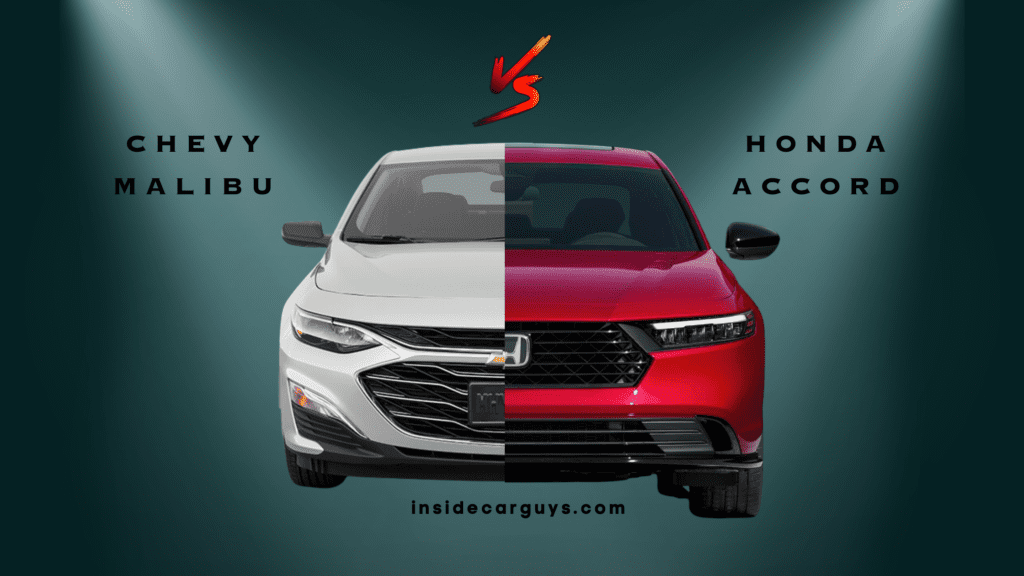The Chevrolet Malibu and Honda Accord have long been pillars of the midsize sedan segment, earning their reputation for comfort, reliability, and value. As you search for your next vehicle, the choice between these two formidable contenders may prove challenging. Fear not, as we’ve meticulously analyzed the nuances and characteristics of each car to guide you in making an informed decision.
In this comparison, we’ll explore the various aspects that make these sedans unique, ultimately helping you determine which one is the perfect fit for you.
Exterior Design
The Chevrolet Malibu and Honda Accord each have distinctive exterior designs that exude elegance and sophistication. The Malibu’s sleek, aerodynamic profile is accentuated by its sculpted lines and bold grille, while the Accord showcases a sporty yet refined appearance with its aggressive front fascia and sweeping roofline.
Interior Design
Inside, both sedans boast comfortable and upscale cabins. The Chevy Malibu’s interior is adorned with soft-touch materials and tasteful chrome accents, creating an atmosphere of luxury. The Honda Accord’s interior is equally impressive, offering a clean, minimalist design with high-quality materials throughout. Ergonomics and intuitive controls are a priority in both vehicles, ensuring drivers can focus on the road with minimal distractions.
Seating
Comfortable seating is paramount in a midsize sedan, and both the Malibu and Accord excel in this area. The Malibu offers ample space for up to five occupants, with well-padded, supportive seats that ensure a comfortable ride on long journeys. The Accord, on the other hand, provides even more legroom and headroom for both front and rear passengers, making it a top choice for those who prioritize spaciousness.
Storage
Cargo capacity is another key consideration when comparing these two sedans. The Chevy Malibu boasts a generous 15.7 cubic feet of trunk space, making it an ideal choice for those who need room for luggage, groceries, or other cargo. The Honda Accord, however, slightly edges out the Malibu in this category with its 16.7 cubic feet of trunk space, providing a bit more room for all your storage needs.
Performance
When it comes to performance, both the Malibu and Accord offer a satisfying driving experience. The Malibu features a standard 1.5-liter turbocharged 4-cylinder engine, delivering 160 horsepower and 184 lb-ft of torque. The Accord comes with a slightly more powerful 1.5-liter turbocharged 4-cylinder engine, producing 192 horsepower and 192 lb-ft of torque. Both vehicles offer optional engines for those seeking more power, but overall, the Accord’s performance feels more engaging and responsive.
Fuel Efficiency
As fuel efficiency becomes increasingly important, both the Malibu and Accord deliver competitive numbers. The base Chevy Malibu offers an EPA-estimated 29 mpg in the city and 36 mpg on the highway, while the base Honda Accord boasts an EPA-estimated 30 mpg in the city and 38 mpg on the highway. Although the difference is minimal, the Accord’s slight advantage in fuel efficiency may sway eco-conscious buyers.
Safety
Safety is a top priority for both Chevrolet and Honda, and their respective midsize sedans reflect that commitment. Both the Malibu and Accord come equipped with a suite of advanced safety features, including forward collision warning, automatic emergency braking, and lane-keeping assist. The Honda Accord, however, takes safety a step further by offering standard adaptive cruise control and traffic sign recognition, giving it a slight edge in this category.
Trim Levels
When it comes to trim levels, both the Malibu and Accord offer a variety of options to cater to diverse buyer preferences. The Chevy Malibu is available in five trims: L, LS, RS, LT, and Premier. Each trim level offers a different set of features, allowing buyers to find the perfect balance of luxury, convenience, and affordability.
The Honda Accord, on the other hand, comes in six trim levels: LX, Sport, Sport Special Edition (SE), EX-L, Touring, and the hybrid-exclusive Touring Hybrid. With a wider range of options, the Accord caters to an even broader audience, ensuring that there is a model to suit every driver’s preferences.
Pricing
Last but certainly not least, pricing plays a significant role in the decision-making process. The base Chevy Malibu L starts at a more budget-friendly price, with an MSRP of around $23,000. As you move up the trim levels, the price increases accordingly, with the top-of-the-line Premier trim starting at approximately $34,000.
The Honda Accord, while slightly more expensive at the base level, offers a competitive price range across its trim levels. The entry-level Accord LX has a starting MSRP of around $25,000, while the luxurious Touring trim begins at roughly $37,000. For those interested in a hybrid option, the Accord Touring Hybrid starts at around $37,500.
Key Differences
Exterior and Interior Design
While both sedans boast elegant and sophisticated designs, the Chevy Malibu has a more aerodynamic and sculpted appearance, with an emphasis on its bold grille. The Honda Accord, on the other hand, showcases a sporty yet refined look, featuring an aggressive front fascia and a sweeping roofline. The interior design of the Malibu is characterized by soft-touch materials and chrome accents, while the Accord offers a clean, minimalist layout.
Performance
The Honda Accord has a slight edge in performance, with its base engine producing 192 horsepower and 192 lb-ft of torque, compared to the Malibu’s base engine output of 160 horsepower and 184 lb-ft of torque. This makes the Accord feel more engaging and responsive on the road.
Fuel Efficiency
The Accord’s base model also leads in fuel efficiency, boasting an EPA-estimated 30 mpg in the city and 38 mpg on the highway, as opposed to the Malibu’s 29 mpg in the city and 36 mpg on the highway. While the difference is small, it might be an important consideration for eco-conscious buyers.
Safety Features
Both vehicles come equipped with advanced safety features; however, the Honda Accord offers standard adaptive cruise control and traffic sign recognition, giving it a slight advantage in the safety department. This additional layer of protection may appeal to drivers who prioritize cutting-edge safety technology.
Trim Levels
The Honda Accord provides more variety in trim levels, with six options (LX, Sport, Sport SE, EX-L, Touring, and Touring Hybrid) compared to the Malibu’s five (L, LS, RS, LT, and Premier). This wider range of choices allows the Accord to cater to an even broader audience, ensuring there’s a model to suit every driver’s preferences.
Pricing
The Chevrolet Malibu is the more budget-friendly option, with a starting MSRP of around $23,000 for the base L trim, compared to the Honda Accord’s base LX trim starting at around $25,000. However, as you move up the trim levels, the price difference narrows, making the decision more about individual preferences and priorities rather than simply cost.
Final Thoughts
After delving deep into the world of the Chevrolet Malibu and Honda Accord, it’s clear that both sedans possess qualities that make them exceptional choices in the midsize segment. Whether you prioritize performance, fuel efficiency, or an array of cutting-edge safety features, both vehicles have something to offer. While the Malibu presents a more budget-friendly option, the Accord shines in terms of performance and available trims.
In the end, the decision boils down to personal preference and priorities. Take the time to test drive both vehicles and experience their unique qualities firsthand, and you’ll be well on your way to selecting the perfect midsize sedan for your needs.
Features Breakdown
Chevrolet Malibu
- Exterior Design:
- Sleek, aerodynamic profile
- Sculpted lines and bold grille
- Interior Design:
- Soft-touch materials and chrome accents
- Luxurious and comfortable cabin
- Seating:
- Comfortable seating for up to five passengers
- Ample space and well-padded seats
- Storage:
- 15.7 cubic feet of trunk space
- Performance:
- Standard 1.5-liter turbocharged 4-cylinder engine
- 160 horsepower and 184 lb-ft of torque
- Fuel Efficiency:
- EPA-estimated 29 mpg city and 36 mpg highway
- Safety:
- Advanced safety features, including forward collision warning, automatic emergency braking, and lane-keeping assist
- Trim Levels:
- L, LS, RS, LT, and Premier
- Pricing:
- Base L trim starts at around $23,000
- Premier trim starts at approximately $34,000
Honda Accord
- Exterior Design:
- Sporty and refined appearance
- Aggressive front fascia and sweeping roofline
- Interior Design:
- Clean, minimalist design with high-quality materials
- Comfortable and spacious cabin
- Seating:
- Spacious seating for up to five passengers
- Extra legroom and headroom for front and rear passengers
- Storage:
- 16.7 cubic feet of trunk space
- Performance:
- Standard 1.5-liter turbocharged 4-cylinder engine
- 192 horsepower and 192 lb-ft of torque
- Fuel Efficiency:
- EPA-estimated 30 mpg city and 38 mpg highway
- Safety:
- Advanced safety features, including adaptive cruise control and traffic sign recognition, in addition to forward collision warning, automatic emergency braking, and lane-keeping assist
- Trim Levels:
- LX, Sport, Sport SE, EX-L, Touring, and Touring Hybrid
- Pricing:
- Base LX trim starts at around $25,000
- Touring trim starts at roughly $37,000
- Touring Hybrid starts at around $37,500





